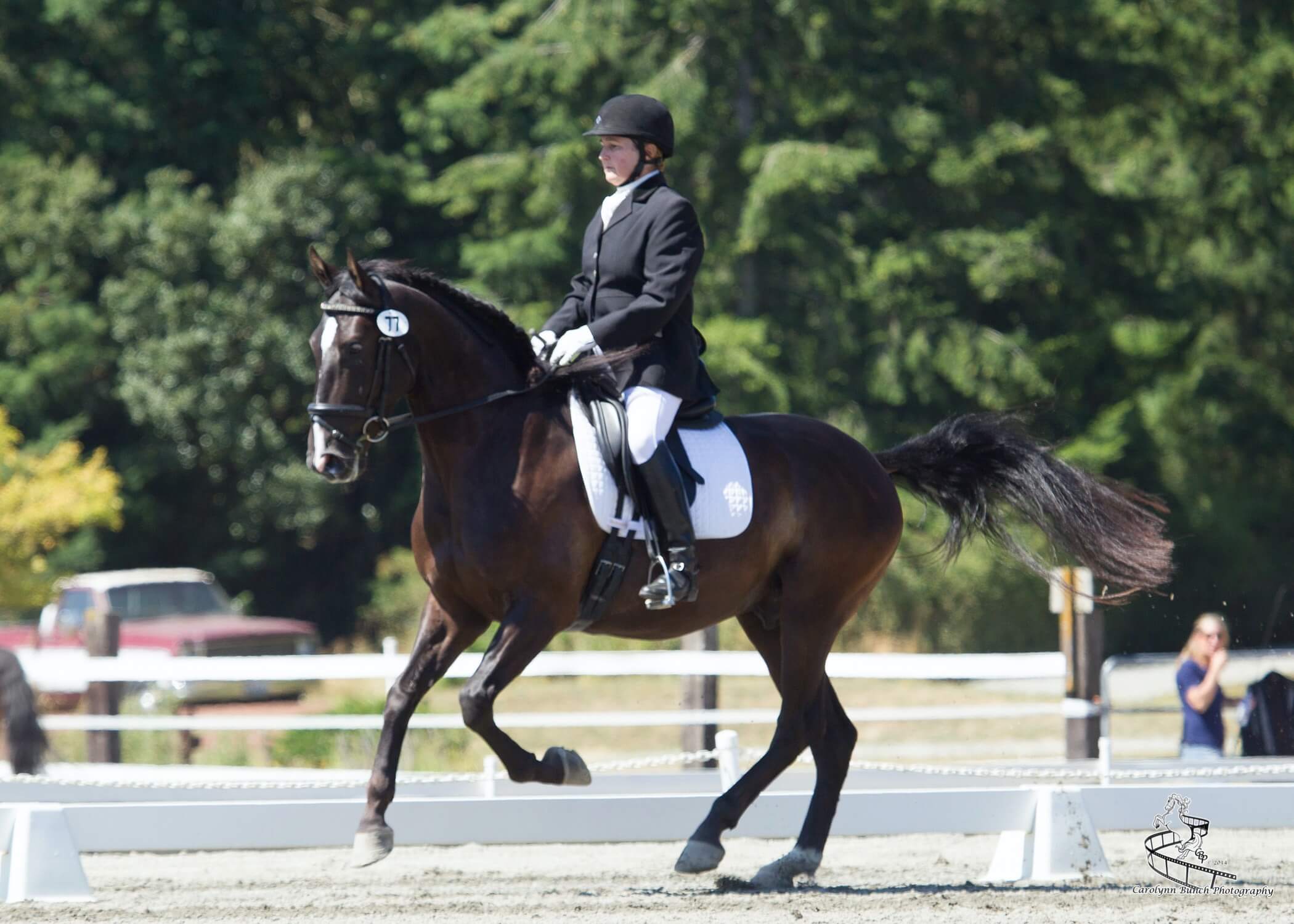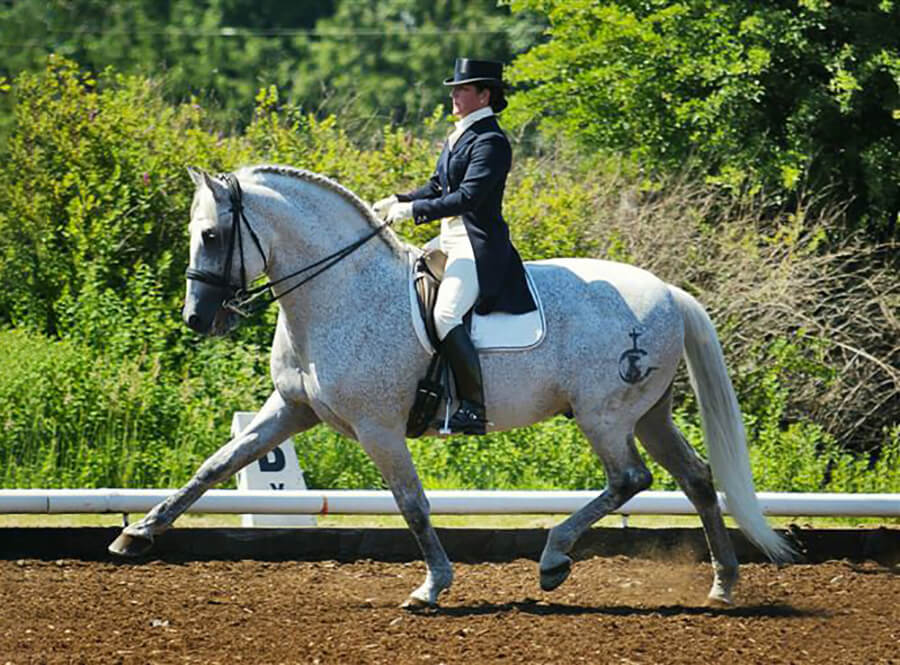Carol Lynn McArdle is a much-loved trainer and clinician in the Pacific Northwest. She regularly travels from her Whidbey Island farm to teach clinics throughout Washington and Oregon (and beyond). She’s known as an instructor who preserves the cheerfulness and positivity in both her equine and human students and helps people from all disciplines improve their riding and training.
What is your name and the name of your business?
Carol Lynn McArdle; Tir na nO’g School of Academic Equitation
What do you do?
I teach people how to train their own horses in the classical tradition of dressage, which is a time-tested philosophy based in a deep knowledge of equine biomechanics and functional anatomy. This may sound like a complicated subject, but it’s actually grounded in common sense, and the basic ideas of making it as easy as possible for horses to carry us around and enjoy being in a relationship with us.
Why did you choose that aspect of the horse business?
For many years I competed on the world stage and represented the United States in international competition. During those years I thought I was doing the best for my horses, that I was a part of something bigger than myself, and that the high level of competition was looking out for the best interests of the horses. The longer I was a part of that world, the more I realized that it was I who was wearing rose colored glasses.
For many people, the horses were a machine—a vehicle for their own interests. I began to realize that even though I was competing at a high level I didn’t understand enough, and I needed a deeper education myself to be the best for my horses. This led me to explore the many different schools (or philosophies) of classical equitation. During those years, I was a student at the Royal Andalusian School of Equestrian Art, The Cadre Noir in France, and a student of several of the world’s most highly revered masters in equestrian art. I learned both the similarities between these different countries and philosophies, and also the differences…which led me to question all of them.
In the end, I realized that I have a simple but very big responsibility to the horses as a rider and trainer. That responsibility is to make it as easy as possible for the horse to carry me around. Dressage principles were originally based on this important principle, but all horse disciplines have moved further and further away from this central imperative. It is my job to help people to come back to it, and in the process help them realize that when they make it easy for the horse, the horse is able to perform at his highest.
Who do you feel influenced you the most in your equestrian journey and why?
I have been very lucky to have been influenced by many great horse people, starting with my first teacher, Col. Andrew D. Pickard. He took me under his wing when I was 10 years old and showed me a model—an image to strive for. He was the last of the great old gentleman equestrian artists.
When I finally moved away, he said to me, “If you remember anything I’ve shown you, remember this: a horse without a rider will always be a horse, but a rider without a horse is just a person like any other person. So, ride your horse to glorify him and diminish yourself. Be like the wind in the grass, you can’t see the wind, but you can see its effect.”
There have been other great influencers in my life: Christopher Bartle, Henrik Johansen, Philipe Karl, Joao Oliveira, Jack LeGoff, Reiner Klimke, Herbert Rehbein, Ian Stark, and many more.
What disciplines/sports or aspects of the industry are you involved in?
I have competed in three-day eventing, dressage, show jumping, and combined driving—all at the international level.
What breeds have you trained?
I’ve had the great opportunity to train many different breeds, including Thoroughbreds, warmbloods, Lusitanos, Andalusians, a few draft horses, and ponies. At one point I was the head trainer for the Bavarian Warmblood Hundred Day Stallion testing.
What aspect of your business is the most intriguing to you?
I am challenged and infinitely intrigued with helping different people learn. We all have strengths in our learning style, and when I have a student who doesn’t understand me, my first thought is that I need to find a different way to explain it to them. The lesson is theirs, not mine. It’s my responsibility to help them and it’s their responsibility to take what I teach them and make it their own.
How many years have you been in business?
This is a good question. I never wanted to be a professional horse person. I was sort of dragged into it kicking and screaming, and then was surprised to find that I had somehow stumbled on to my “right” profession. I taught those people who asked for my help without being paid for all the years I was at university and did not actually start doing it as a business until I had already represented the US in international competition. So, I have been in this as a profession for 35 years and riding horses for 60 years.
What are your business goals? Where do you hope to be in 5 years?
My business goals are the same today as they’ve always been: to help people learn to train their own horses. In five years I hope to still be doing this to whatever degree I am needed. When you are as old as I am, your ambition to do great things is replaced with a desire to do your job with great patience and a heartfelt desire to help.
Notable accomplishments?
I imagine this question is asking about competition accomplishments; however, I think my greatest accomplishment was realizing (after I had already represented my country in international competition) that I really didn’t know as much as I thought I knew. I realized that I needed a deeper base of knowledge and understanding of horses, riding, and training. So, I continued my education. I went back to Europe and trained with several masters and it changed my course to be a teacher, rather than just a rider.
Training philosophy?
Because it is difficult for horses to carry us around, it’s our responsibility to make it as easy as possible for them. This requires us to have a deep understanding of equine biomechanics and functional anatomy. The process is simple (it’s not always easy) but it’s not complicated. Our first responsibility is to remember that the horse is not a vehicle for our ends.
Contact Carol Lynn McArdle
Email: [email protected]
Website: www.tirnanogdressage.com (currently down due to being rebuilt)
Phone: 425-417-9270
The Northwest Horse Source is celebrating Northwest trainers and instructors! Trainer’s Profile is a monthly column that spotlights trainers in multiple disciplines from all over the Northwest. We believe that connecting riders, trainers, and horses is necessary for success in the horse business. It’s our goal to support the equestrian lifestyle for all our readers.
If you’re a trainer who’d like to be featured in the Northwest Horse Source, click here and answer the questions for a chance to have your business profile published in The Northwest Horse Source magazine and website. Thanks for sharing your story!
See this article in the September 2021 online edition:

Kim Roe grew up riding on the family ranch and competed in Western rail classes, trail horse, reining, working cow, and hunter/jumper. She trained her first horse for money at 12 years old, starting a pony for a neighbor.
Kim has been a professional dressage instructor in Washington state for over 30 years, training hundreds of horses and students through the levels. In recent years Kim has become involved in Working Equitation and is a small ‘r’ Working Equitation judge with WE United.
Kim is the editor of the Northwest Horse Source Magazine, and also a writer, photographer, and poet. She owns and manages Blue Gate Farm in Deming, Washington where she continues to be passionate about helping horses and riders in many disciplines.






